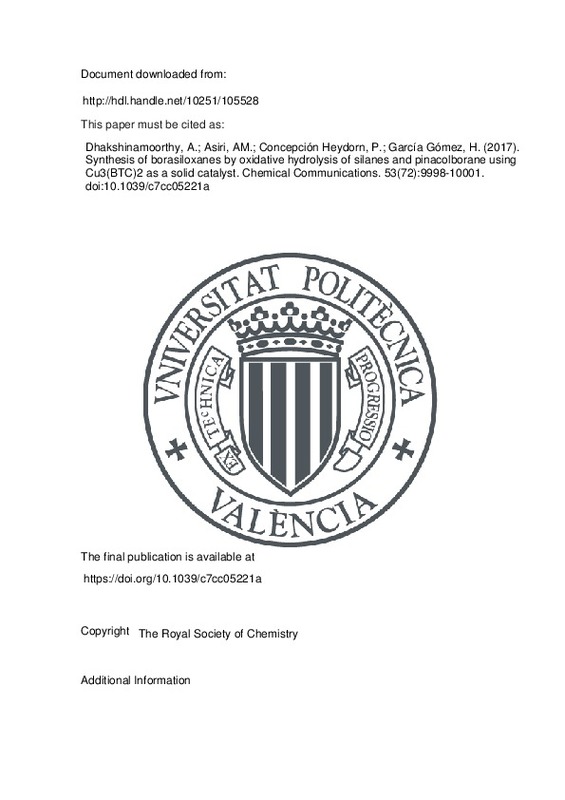Liu, W., Pink, M., & Lee, D. (2009). Conjugated Polymer Sensors Built on π-Extended Borasiloxane Cages. Journal of the American Chemical Society, 131(24), 8703-8707. doi:10.1021/ja902333p
Khelevina, O. G., & Malyasova, A. S. (2014). Cross-linking of borosiloxane oligomers and properties of materials with vulcanized borosiloxane coating. Russian Journal of Applied Chemistry, 87(4), 480-484. doi:10.1134/s10704272140400144
Puneet, P., Vedarajan, R., & Matsumi, N. (2016). Alternating Poly(borosiloxane) for Solid State Ultrasensitivity Toward Fluoride Ions in Aqueous Media. ACS Sensors, 1(10), 1198-1202. doi:10.1021/acssensors.6b00346
[+]
Liu, W., Pink, M., & Lee, D. (2009). Conjugated Polymer Sensors Built on π-Extended Borasiloxane Cages. Journal of the American Chemical Society, 131(24), 8703-8707. doi:10.1021/ja902333p
Khelevina, O. G., & Malyasova, A. S. (2014). Cross-linking of borosiloxane oligomers and properties of materials with vulcanized borosiloxane coating. Russian Journal of Applied Chemistry, 87(4), 480-484. doi:10.1134/s10704272140400144
Puneet, P., Vedarajan, R., & Matsumi, N. (2016). Alternating Poly(borosiloxane) for Solid State Ultrasensitivity Toward Fluoride Ions in Aqueous Media. ACS Sensors, 1(10), 1198-1202. doi:10.1021/acssensors.6b00346
Han, Y.-K., Yoo, J., & Yim, T. (2016). Distinct Reaction Characteristics of Electrolyte Additives for High-Voltage Lithium-Ion Batteries: Tris(trimethylsilyl) Phosphite, Borate, and Phosphate. Electrochimica Acta, 215, 455-465. doi:10.1016/j.electacta.2016.08.131
Makarova, E. A., Shimizu, S., Matsuda, A., Luk’yanets, E. A., & Kobayashi, N. (2008). meso-Aryl tribenzosubporphyrin—a totally substituted subporphyrin species. Chemical Communications, (18), 2109. doi:10.1039/b801712c
Neville, L. A., Spalding, T. R., & Ferguson, G. (2000). A Novel Borosilicate Cage Compound with an Incomplete B4Si4 Cube Structure: [(tBuSi)4(CH2=CHC6H4B)4O10]. Angewandte Chemie, 39(20), 3598-3601. doi:10.1002/1521-3773(20001016)39:20<3598::aid-anie3598>3.0.co;2-a
Mingotaud, A.-F., Héroguez, V., & Soum, A. (1998). Synthesis of difunctional borasiloxanes and their behavior in metathesis reactions. Journal of Organometallic Chemistry, 560(1-2), 109-115. doi:10.1016/s0022-328x(98)00498-7
Beckett, M. A., Rugen-Hankey, M. P., & Sukumar Varma, K. (2003). Synthesis and characterisation of cyclo-boratetrasiloxane, (RBO)(Me2SiO)3 (R=nBu, Ar), derivatives. Polyhedron, 22(25-26), 3333-3337. doi:10.1016/s0277-5387(03)00478-9
Schiavon, M. A., Armelin, N. A., & Yoshida, I. V. P. (2008). Novel poly(borosiloxane) precursors to amorphous SiBCO ceramics. Materials Chemistry and Physics, 112(3), 1047-1054. doi:10.1016/j.matchemphys.2008.07.041
Brisdon, B. J., Mahon, M. F., Molloy, K. C., & Schofield, P. J. (1992). Synthesis and structural characterization of cycloborasiloxanes: The X-ray crystal structures of cyclo-1,3,3,5,5-pentaphenyl-1-bora-3,5-disiloxane and cyclo-1,3,3,5,7,7-hexaphenyl-1,5-dibora-3,7-disiloxane. Journal of Organometallic Chemistry, 436(1), 11-22. doi:10.1016/0022-328x(92)85022-o
Murphy, D., Sheehan, J. P., Spalding, T. R., Ferguson, G., Lough, A. J., & Gallagher, J. F. (1993). Compounds containing B–O–X bonds (X = Si, Ge, Sn, Pb). Part 4.—Crystal structures of B(OSiPh3)3, PhB(OSiPh3)2and PhB(OGePh3)2. J. Mater. Chem., 3(12), 1275-1283. doi:10.1039/jm9930301275
Zhao, Z., Cammidge, A. N., & Cook, M. J. (2009). Towards black chromophores: μ-oxo linked phthalocyanine–porphyrin dyads and phthalocyanine–subphthalocyanine dyad and triad arrays. Chemical Communications, (48), 7530. doi:10.1039/b916649a
Fujdala, K. L., Oliver, A. G., Hollander, F. J., & Tilley, T. D. (2003). Tris(tert-butoxy)siloxy Derivatives of Boron, Including the Boronous Acid HOB[OSi(OtBu)3]2and the Metal (Siloxy)boryloxide Complex Cp2Zr(Me)OB[OSi(OtBu)3]2: A Remarkable Crystal Structure with 18 Independent Molecules in Its Asymmetric Unit. Inorganic Chemistry, 42(4), 1140-1150. doi:10.1021/ic0205482
Kleeberg, C., Cheung, M. S., Lin, Z., & Marder, T. B. (2011). Copper-Mediated Reduction of CO2with pinB-SiMe2Ph via CO2Insertion into a Copper–Silicon Bond. Journal of the American Chemical Society, 133(47), 19060-19063. doi:10.1021/ja208969d
Metcalfe, R. A., Kreller, D. I., Tian, J., Kim, H., Taylor, N. J., Corrigan, J. F., & Collins, S. (2002). Organoborane-Modified Silica Supports for Olefin Polymerization: Soluble Models for Metallocene Catalyst Deactivation. Organometallics, 21(8), 1719-1726. doi:10.1021/om010284b
Kijima, I., Yamamoto, T., & Abe, Y. (1971). Alkoxysilanes. VIII. The Preparation of Alkoxysiloxy Derivatives of Aluminum and Boron. Bulletin of the Chemical Society of Japan, 44(11), 3193-3194. doi:10.1246/bcsj.44.3193
Marciniec, B., & Walkowiak, J. (2008). New catalytic route to borasiloxanes. Chemical Communications, (23), 2695. doi:10.1039/b801013g
Ohmura, T., Torigoe, T., & Suginome, M. (2012). Catalytic Functionalization of Methyl Group on Silicon: Iridium-Catalyzed C(sp3)–H Borylation of Methylchlorosilanes. Journal of the American Chemical Society, 134(42), 17416-17419. doi:10.1021/ja307956w
Yoshimura, A., Yoshinaga, M., Yamashita, H., Igarashi, M., Shimada, S., & Sato, K. (2017). A convenient and clean synthetic method for borasiloxanes by Pd-catalysed reaction of silanols with diborons. Chemical Communications, 53(43), 5822-5825. doi:10.1039/c7cc02420g
Ito, M., Itazaki, M., & Nakazawa, H. (2014). Selective Boryl Silyl Ether Formation in the Photoreaction of Bisboryloxide/Boroxine with Hydrosilane Catalyzed by a Transition-Metal Carbonyl Complex. Journal of the American Chemical Society, 136(17), 6183-6186. doi:10.1021/ja500465x
Chatterjee, B., & Gunanathan, C. (2017). Ruthenium-catalysed multicomponent synthesis of borasiloxanes. Chemical Communications, 53(16), 2515-2518. doi:10.1039/c7cc00787f
Huang, Y.-B., Liang, J., Wang, X.-S., & Cao, R. (2017). Multifunctional metal–organic framework catalysts: synergistic catalysis and tandem reactions. Chemical Society Reviews, 46(1), 126-157. doi:10.1039/c6cs00250a
Dhakshinamoorthy, A., Asiri, A. M., & Garcia, H. (2016). Mixed-metal or mixed-linker metal organic frameworks as heterogeneous catalysts. Catalysis Science & Technology, 6(14), 5238-5261. doi:10.1039/c6cy00695g
Dhakshinamoorthy, A., Alvaro, M., & Garcia, H. (2010). Aerobic Oxidation of Benzylic Alcohols Catalyzed by Metal−Organic Frameworks Assisted by TEMPO. ACS Catalysis, 1(1), 48-53. doi:10.1021/cs1000703
Schlichte, K., Kratzke, T., & Kaskel, S. (2004). Improved synthesis, thermal stability and catalytic properties of the metal-organic framework compound Cu3(BTC)2. Microporous and Mesoporous Materials, 73(1-2), 81-88. doi:10.1016/j.micromeso.2003.12.027
Dhakshinamoorthy, A., Alvaro, M., & Garcia, H. (2010). Metal-Organic Frameworks as Efficient Heterogeneous Catalysts for the Regioselective Ring Opening of Epoxides. Chemistry - A European Journal, 16(28), 8530-8536. doi:10.1002/chem.201000588
Dhakshinamoorthy, A., Alvaro, M., & Garcia, H. (2009). Metal organic frameworks as efficient heterogeneous catalysts for the oxidation of benzylic compounds with t-butylhydroperoxide. Journal of Catalysis, 267(1), 1-4. doi:10.1016/j.jcat.2009.08.001
Opanasenko, M., Dhakshinamoorthy, A., Shamzhy, M., Nachtigall, P., Horáček, M., Garcia, H., & Čejka, J. (2013). Comparison of the catalytic activity of MOFs and zeolites in Knoevenagel condensation. Catal. Sci. Technol., 3(2), 500-507. doi:10.1039/c2cy20586f
Chui, S. S. (1999). A Chemically Functionalizable Nanoporous Material [Cu3(TMA)2(H2O)3]n. Science, 283(5405), 1148-1150. doi:10.1126/science.283.5405.1148
Dhakshinamoorthy, A., Concepcion, P., & Garcia, H. (2016). Dehydrogenative coupling of silanes with alcohols catalyzed by Cu3(BTC)2. Chemical Communications, 52(13), 2725-2728. doi:10.1039/c5cc10216b
Dhakshinamoorthy, A., Alvaro, M., & Garcia, H. (2017). HKUST-1 catalyzed room temperature hydrogenation of acetophenone by silanes. Catalysis Communications, 97, 74-78. doi:10.1016/j.catcom.2017.03.023
Bennett, E., Wilson, T., Murphy, P. J., Refson, K., Hannon, A. C., Imberti, S., … Parker, S. F. (2015). How the Surface Structure Determines the Properties of CuH. Inorganic Chemistry, 54(5), 2213-2220. doi:10.1021/ic5027009
[-]







![[Cerrado]](/themes/UPV/images/candado.png)


